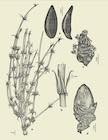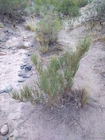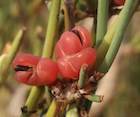Ephedra ochreata
Miers 1863
Common names
Caman, Fruta de Pichi, Solupe (Bell and Bachman 2011).
Taxonomic notes
Description
Dioecious shrubs up to 1 m tall. Leaves in whorls of 3 or 4, coriaceousy, stiff, persistent; apex acuminate. Pollen cones simple, sessile, pyramidal, bracts also in 3's and 4's. Seed cones sessile, bracts fused for almost their entire length. Mature seed cones red, fleshy, bearing (2-)3-4 seeds (Martínez Carretero 2018). Photographs suggest the species is distinctive for the large number of pollen cones, commonly 8-12, whorled at the nodes.
Martínez Carretero (2018) also gives a key to the six Argentine species of Ephedra.
Distribution and Ecology
Chile (uncommon) and Argentina, occurring from Catamarca province in the north to Santa Cruz province in the south, at elevations of 0 to 2,100 m, on sandy or gravelly soils; common on dunes. The plant is common, abundant, widespread, and there are no recorded threats; thus it is not of conservation concern (Bell and Bachman 2011).
Remarkable Specimens
No data as of 2023.03.03.
Ethnobotany
Observations
Remarks
The epithet ochreata (Latin) means "sheathed", in reference to the leaves.
Citations
Bell, A. and S. Bachman. 2011. Ephedra ochreata. The IUCN Red List of Threatened Species 2011. https://www.iucnredlist.org/species/201666/9160011, accessed 2021.12.27.
Martínez Carretero, Eduardo. 2018. Ephedraceae Dumort. in Flora de Mendoza, Multequina 27: Fascículo 10, FM 1-9. Available: https://www.redalyc.org/jatsRepo/428/42857911008/42857911008.pdf, accessed 2021.12.26.
Miers, J. 1863. On Ephedra. Ann. Mag. Nat. Hist., ser. 3, 11: 257. Available: Biodiversity Heritage Library, accessed 2021.12.27. The portion of this paper beginning on page 248 is a fairly interesting read, discussing general biology of Ephedra (not to be taken as accurate) and attempting to describe all South American species; although, many of Miers' taxa have since been reduced to synonymy, esp. with E. chilensis.
See also
Species profile at Plants of the World Online, accessed 2021.12.27.




